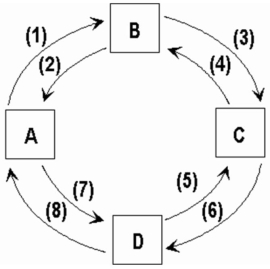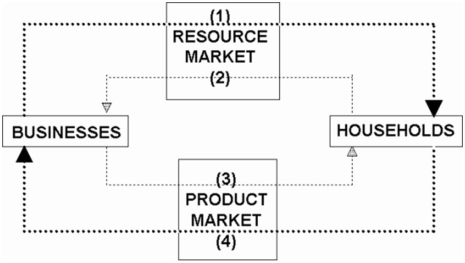A) What will be produced?
B) How is the output to be produced?
C) How can the system accommodate change?
D) Who is to receive the output?
Correct Answer

verified
Correct Answer
verified
Multiple Choice
The idea that firms and resource suppliers in seeking to further their own self-interests in a competitive market economy also simultaneously promotes the public or social interest is a description of:
A) the guiding function of prices.
B) capital accumulation.
C) the "invisible hand."
D) "dollar votes."
Correct Answer

verified
Correct Answer
verified
Multiple Choice
Suppose industry A is realizing substantial economic profits. Which of the following best describes the adjustment process which would bring about a new equilibrium?
A) Firms will leave the industry, output will fall, and product price will rise.
B) Firms will enter the industry, output will rise, and product price will rise.
C) Firms will leave the industry, output will rise, and product price will fall.
D) Firms will enter the industry, output will rise, and product price will fall.
Correct Answer

verified
Correct Answer
verified
Multiple Choice
 -In terms of the circular flow diagram businesses obtain revenue through the _____ market and make expenditures in the _____ market.
-In terms of the circular flow diagram businesses obtain revenue through the _____ market and make expenditures in the _____ market.
A) product; financial
B) factor; product
C) product; factor
D) capital; product
Correct Answer

verified
Correct Answer
verified
Multiple Choice
 -Refer to the circular flow model of the economy. In the diagram flow (1) represents:
-Refer to the circular flow model of the economy. In the diagram flow (1) represents:
A) wage, rent, interest, and profit income.
B) land, labour, capital, and entrepreneurial ability.
C) goods and services.
D) consumer expenditures.
Correct Answer

verified
Correct Answer
verified
True/False
A division of labour enhances society's output by permitting people to take advantage of existing differences in their abilities and skills.
Correct Answer

verified
Correct Answer
verified
Multiple Choice
The private ownership of property resources and use of prices to direct and coordinate economic activity is characteristic of:
A) a command system.
B) a market system.
C) communism.
D) socialism.
Correct Answer

verified
Correct Answer
verified
Multiple Choice
Competition denotes a condition where:
A) there is only one seller in a market.
B) a given product can be purchased at a range of prices.
C) there are many independent buyers and sellers in a market.
D) a few sellers attempt to garner a larger share of the market by cutting prices.
Correct Answer

verified
Correct Answer
verified
Multiple Choice
 -Refer to the figure. If box B represents the factor market and flow (3) represents money income, then:
-Refer to the figure. If box B represents the factor market and flow (3) represents money income, then:
A) box A is the product market and box C is households.
B) box C is the product market and box A is households.
C) box D is the product market and box C is households.
D) box C is the product market and box D is households.
Correct Answer

verified
Correct Answer
verified
True/False
In a competitive market economy, firms and resource suppliers will seek to further their own self-interest, but at the same time, as if guided by an "invisible hand," they will promote the public interest.
Correct Answer

verified
Correct Answer
verified
Multiple Choice
In a market system, well-defined property rights are important because they:
A) increase unnecessary investment.
B) limit destructive economic growth.
C) create economic problems.
D) encourage economic activity.
Correct Answer

verified
Correct Answer
verified
Multiple Choice
If an increase occurs in the demand for product X, we would expect all of the following to occur except:
A) an increase in the profits of industry X.
B) an increase in the demand for resources employed by industry X.
C) an increase in the output of industry X.
D) a decrease in the prices of resources employed in industry X.
Correct Answer

verified
Correct Answer
verified
Multiple Choice
Consumers express self-interest when they:
A) reduce business losses.
B) collect economic profits.
C) seek the lowest price for the product.
D) search for jobs with the highest wage
Correct Answer

verified
Correct Answer
verified
Multiple Choice
Specialization in production is economically beneficial primarily because it:
A) allows everyone to have a job which they like.
B) permits the production of a larger output with fixed amounts of resources.
C) facilitates trade by bartering.
D) guarantees full employment.
Correct Answer

verified
Correct Answer
verified
Multiple Choice
How do workers typically express self-interest?
A) by minimizing the economic losses of other business firms
B) by maximizing the economic profits of other business firms
C) by seeking the highest price when purchasing a consumer product
D) by seeking jobs with the best combination of wages and benefits
Correct Answer

verified
Correct Answer
verified
Multiple Choice
The command system is also known as:
A) the market system.
B) pure capitalism.
C) market socialism.
D) socialism or communism.
Correct Answer

verified
Correct Answer
verified
Multiple Choice
Economic efficiency would be primarily discussed in response to which of the fundamental questions about a competitive market economy?
A) What will be produced?
B) How will the goods and services be produced?
C) How will the system accommodate change?
D) Who is to receive the output?
Correct Answer

verified
Correct Answer
verified
Multiple Choice
Property rights are important because they:
A) encourage investment and growth.
B) are conducive to the writing of books and music.
C) facilitate exchange.
D) do all of the above.
Correct Answer

verified
Correct Answer
verified
Multiple Choice
Which of the following best describes the "invisible hand" concept?
A) The desires of resource suppliers and producers to further their own self-interest will automatically further the public interest.
B) The nonsubstitutability of resources gives rise to a conflict between private and public interests and the need for government intervention.
C) Mixed capitalism is the best system for overcoming the scarce resources-unlimited wants problem.
D) Central direction by the government will improve resource allocation in a capitalistic economy.
Correct Answer

verified
Correct Answer
verified
Multiple Choice
The idea that the desires of resource suppliers and producers to further their own self-interest will automatically further the public interest is known as:
A) consumer sovereignty.
B) the invisible hand.
C) derived demand.
D) profit maximization.
Correct Answer

verified
Correct Answer
verified
Showing 41 - 60 of 112
Related Exams